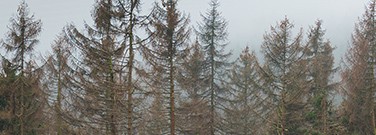Dead Trees Add to Mix of Greenhouse Gases

By Christina P. Hooton
Ghost forests, or forests of dead trees, form along coasts like eerie harbingers. These trees, once part of healthy woodland, are poisoned by saltwater as sea levels rise, a condition that is expected to increase as climate change advances. According to a new study published in Biogeochemistry, they’re becoming a source of greenhouse gas emissions to watch.
Haunted by Climate Change
“The emergence of ghost forests is one of the biggest changes happening in response to sea level rise,” said Keryn Gedan, a coastal ecologist at George Washington University in Washington, DC. Gedan, who was not involved in the work, was quoted in the Science News article “‘Tree farts’ contribute about a fifth of greenhouse gases from ghost forests” by Maria Temming.
Gedan explained that eventually, these areas would become carbon “sinks,” as wetlands store more carbon than forests. But in the short term, the dead trees stop absorbing carbon dioxide through photosynthesis and instead release greenhouse gases. Referred to as “tree farts,” these gas emissions are created by microbes in the soil and trees, just like the farts of people and animals, which are the result of microbes that live in the gut.
Assessing the Damage
Equipped with portable gas analyzers, researchers measured carbon dioxide (CO2), methane, and nitrous oxide emissions from dead trees and soil in five ghost forests on the Albermarle-Pamlico Peninsula in North Carolina.
The soil in these areas gives off more greenhouse gases than trees, emitting an average of 416 milligrams of CO2, 5.9 milligrams of methane, and 0.1 milligrams of nitrous oxideper square meter of ground per hour. Dead trees emit 116 milligrams of CO2, 0.3 milligrams of methane, and 0.04 milligrams of nitrous oxide for the same amount of space and time. In comparison, a dairy cow can emit up to 27 grams of methane per hour.
Researchers noted that the dead trees increased greenhouse gas emissions of the overall ecosystem by about 25 percent. “Even though these standing dead trees are not emitting as much as the soils, they’re still emitting something, and they definitely need to be accounted for,” said the study’s lead author Melinda Martinez, a graduate student in forestry and environmental resources at North Carolina State University, in a university news release. “Even the smallest fart counts.”
Studies like this one have the potential to help us see a more complete picture of climate change, giving us the data we need to understand its compounding effects.
Discussion Questions
- Brainstorm sources of greenhouse gas emissions. Rank them on a scale of 1 to 10, 1 being the lowest emitters and 10 being the greatest. See if you can verify your hunches.
- Talk about the relationship between greenhouse gas emissions, rising sea levels, and warmer weather. Explain how they all interact to further the effects of climate change.
Vocabulary
- Greenhouse gas
- Photosynthesis
- Ecosystem